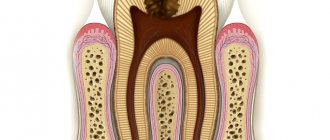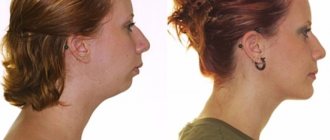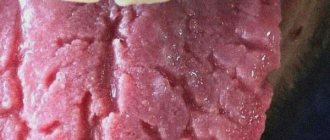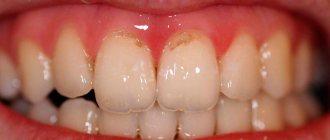An orthodontist makes such a diagnosis with code K07.3 according to ICD-10 (International Classification of Diseases, 10th revision) if the tooth has erupted with an inclination or displacement, or has completely appeared outside the dental arch. This mainly happens to the lower eighth molars, incisors and canines.
A companion to dystopia can be other anomalies in the position of the teeth - crowding, displaced or open bite, as well as retention.
Reasons for appearance
- Heredity. If a child inherited, for example, large teeth from his father and a small jaw from his mother, dystopia cannot be avoided. In addition, it can be inherited on its own.
- Atypical formation of dental tissue primordia in the embryo.
- Injuries and bad habits: prolonged use of a pacifier, the habit of biting a pencil, etc.
- Early removal of baby teeth.
- Peculiarities of eruption time. For example, if fangs appear late, that is, after 9 years, there may no longer be room for them in the arch.
- Dystopia is often caused by polyodontia (“extra teeth”), macrodentia (abnormally large teeth), partial absence of teeth or a sharp discrepancy between the size of primary and permanent teeth.
Possible causes of anomaly development and patients at risk
Anomalies in eruption do not arise out of nowhere. But there are quite a few possible reasons for their development. The following are the main and most common prerequisites:
- genetics – hereditary features in the structure of the jaw apparatus,
- eighth molars – their late eruption is almost always difficult. The problem may be the incorrect position of the buds, insufficient space for eruption, increased density of soft tissues, etc.
- jaw injuries,
- malocclusion – including the presence of oversized units that are redundant and take up other people’s places,
- dental diseases - inflammatory processes, caries, premature tooth loss,
- delayed change of bite,
- systemic disorders - somatic disorders, infectious diseases, rickets, metabolic disorders and other malfunctions of internal organs and systems.
Retention in childhood most often results from metabolic disorders in the body, as well as diseases of the skeletal system. The pathology may be congenital or acquired. Those who have hereditary preconditions are at increased risk. Often the anomaly is diagnosed against the background of chronic pathologies of periodontal tissue.
Types of dystopia
Depending on how and where the crown is displaced, several types of pathology are distinguished:
- A tilt towards the vestibule of the mouth means that we are talking about the vestibular position of the dystopic tooth, and if, on the contrary, in the depths of the oral cavity, we are talking about the oral position.
- When the body of the tooth is completely located outside the arch and moves forward or backward, the dentist will note in the chart the presence of a mesial or distal position, respectively.
- Is the newbie cutting higher than the rest? – Such an anomaly will be called supraposition. If lower, infra position.
- Rare anomalies are torto- and transposition. In the first case, the tooth rotates around its axis, in the second, it changes places with its neighbor, for example, a canine takes the place of a premolar.
Depending on which tooth is in the wrong position, dystopia of incisors, canines, molars and premolars or “eights” is distinguished.
Postoperative care
After removal of the deformed area, the patient begins the postoperative period. Its duration and result depend on which tooth was removed and how the operation went. Since the problem most often occurs with the third molars, dentists pay more attention to them.
After removing the dystopic figure eights on the lower jaw, sutures are applied. A tampon is placed in place of the hole, which must be bitten and held tightly for 15 to 20 minutes. During this time, the patient must be under the supervision of specialists. When the doctor is convinced that the bleeding does not threaten the person, he is sent home. Uncomplicated operations do not require hospitalization. After 2–3 hours, the patient can eat food.
Recommendations:
- do not rinse the hole yourself;
- avoid thermal procedures and physical activity;
- try to chew food on this day on the other side of the jaw;
- do not drink alcohol or smoke after the intervention;
- refuse hot and cold dishes, do not drink coffee;
- Visit your doctor regularly for dressing changes.
Dystopic wisdom tooth
The eighth molars are the last to appear, and that is why they are associated with the greatest risk of dystopia.
The bone tissue has already been formed, and often there is no longer room for a newcomer in the dental arch. In addition, any indigenous is preceded by a dairy pioneer who “breaks” the path. The “wise” molar does not have such an assistant, just as there are no neighboring teeth that determine the correct position on the arch.
Dystopic wisdom tooth
Classification
Based on the analysis of the etiological factors of resorption, the authors proposed various classifications of this pathological process.
Thus, in particular, J. Andreasen [4] over the past 40 years has made a unique contribution to the understanding of tooth resorption after trauma. He proposed a classification that remains the most common to this day, and highlighted:
- internal resorption, which is divided into inflammatory and replacement;
- external resorption, which is divided into inflammatory and replacement.
However, this classification does not include other resorption processes that have been identified over the past two decades.
In 1999, M. Gunraj [28] proposed a more detailed classification:
Pathological tooth resorption:
1) External resorption:
a) external resorption caused by tooth trauma:
- superficial resorption;
- inflammatory resorption;
- replacement resorption;
b) external resorption caused by pulp necrosis and periapical pathology;
c) external resorption caused by pressure in the periodontal ligament;
2) internal resorption;
3) external invasive cervical resorption.
Today, hyperplastic processes leading to resorption of hard dental tissues are distinguished separately: invasive cervical resorption, invasive coronal resorption and internal replacement (invasive) resorption [32, 35].
The most recognized and convenient in clinical practice is the classification proposed by S. Lindskog [44] in 2006, based on the etiological factor causing pathological resorption of hard dental tissues. Three large groups were identified:
1) Resorption caused by trauma:
a) superficial resorption;
b) transient internal resorption;
c) resorption caused by pressure and orthodontic treatment;
d) replacement resorption.
2) Resorption caused by inflammation:
a) internal inflammatory (infectious) root resorption:
- apical;
— intrachannel;
b) external inflammatory resorption of roots;
c) combined internal and external inflammatory root resorption.
3) Hyperplastic invasive resorptions:
a) internal invasive (replacement) resorption;
b) invasive coronal resorption;
c) invasive cervical resorption.
Later, G. Heithersay [32] supplemented the classification of invasive cervical resorption, which includes 4 classes according to the degree of damage to hard tissues.
Class 1: small invasive lesion in the cervical area with slight penetration into dentin.
Class 2: Characterized by a well-defined invasive resorptive lesion that extends close to the coronal pulp chamber but has little or no involvement of the radicular dentin.
Grade 3: Defined by deeper invasion of dentin by tissue resorption, not only involving coronal dentin, but also extending to at least the coronal third of the root.
Grade 4: characterized by a large invasive resorptive process that extends beyond the coronal third of the root canal.
According to ICD-10, Pathological tooth resorption is designated by code K03.3 and is divided as follows:
- internal pulp granuloma;
— resorption of hard dental tissues (external).
Possible complications
A dystopic tooth can injure the oral mucosa, tongue and cheeks, resulting in decubital ulcers.
Anomalies in the position of crowns and malocclusion are a common cause of caries: oral hygiene becomes more complicated, and it is difficult to completely remove plaque and food debris from the interdental spaces.
Another complication is problems with diction and chewing food.
Also, inflammation often occurs above the part of the crown that has not yet erupted - pericoronitis. And in the most difficult cases, the “problem” tooth erupts outside the alveolar arch, which, of course, entails not only serious discomfort, but also diseases of other organs.
Clinical manifestations
A clinically unerupted tooth may not manifest itself in any way, and the person will not even know about the presence of a problem. Sometimes this state of affairs persists for life, and treatment is not required. But in almost 80% of cases, an impacted tooth causes a disorder, and then the person is forced to seek dental help.
As a rule, problems arise when wisdom teeth erupt incompletely. Then a hood forms over the crown - a gum overhang over the tooth, where food gets clogged and plaque accumulates. Over time, this causes inflammation - pericoronitis, during which the soft tissues become red, swollen and cause pain of varying degrees of intensity. A colorless or slightly cloudy liquid may be released from under the hood [11, 23].
If pericoronitis is limited to the catarrhal phase, the patient’s well-being practically does not suffer. But if the situation worsens and pericoronitis becomes purulent, problems appear with opening the mouth due to significant swelling of the mucous membrane surrounding the causative tooth, pain appears with shooting in the temporal, ear or occipital region on the affected side. The tonsil on the side of the impacted tooth can also become inflamed, and drops of pus are released from under the overhanging gum. General well-being is also affected - body temperature can rise to 37.8 - 38 degrees, regional lymph nodes enlarge, weakness and headache appear [5, 19].
Repeated repetitions of acute pericoronitis, interspersed with periods of good health, indicate the transition of the disease to the chronic stage. In this case, the pain when closing the jaws or chewing is moderate, and the formation of ulcers in the hood area comes to the fore. They appear due to the biting of swollen gums by antagonist teeth. A small amount of purulent contents is usually released from under the hood. General health is usually satisfactory, despite the fact that pericoronitis causes frequent exacerbations [4, 7].
If an impacted tooth is located in the frontal zone, a person may complain about the unattractive appearance of the dentition and reduced aesthetics of the smile. However, there may be no other complaints [14].
Treatment of dystopia
The method of therapy depends on the condition of the dystopic tooth and its useful load. Sometimes it is enough just to polish the sharp edges and give it a shape that will not injure the mucous membrane.
Most often, when a tooth is in an incorrect position, they resort to orthodontic treatment methods. Braces allow you to cope with serious malocclusions. If there is no room for a tooth, and this is, for example, a canine that is important from the point of view of functionality and aesthetics, then you will have to remove its neighbors and only then begin orthodontic treatment.
Treatment of dystopia with braces
Prices for removal of impacted teeth
If there is an extraction procedure that qualifies as complex, its cost will be higher than the price for a simple removal. Also, much in this matter will depend on the individual characteristics of the clinical picture and the pricing policy of the dental center. Such a procedure can cost from 10 to 15 thousand rubles. Please note that the preferred method of pain relief requires a separate payment.
- According to WHO.
- Vakushina E.A., Desyatnikova M.O. Increasing the effectiveness of diagnostic methods and treatment of patients with impacted teeth, 2003.
When to remove a dystopic tooth
Removal is not a pleasant procedure, and therefore is always a last resort. It is used in the following cases:
- in the presence of pulpitis, periodontitis or cysts;
- if it is a wisdom tooth complicating the treatment of caries of the seventh molars;
- when the anomaly is accompanied by osteomyelitis or periostitis;
- if surrounding tissues are seriously injured.
If there are no such indications, the dentist will do everything possible to save the dystopic tooth. Note that it is optimal to undergo treatment before the end of growth of the facial skeleton, that is, up to 14-16 years. In this case, you will see results faster, and they will be noticeably better than if you consult a specialist later.
Find out what retention is fraught with and how to eliminate it.
Signs and symptoms, how to diagnose
Now let's move on to the question of how to understand that there is a problem. Sometimes complete retention occurs with virtually no symptoms, and then the dentist can detect it at an appointment or using an x-ray. If the tooth does erupt partially, you can notice it yourself at home. It is necessary to carefully examine the problem area, try to feel the crown growing under the gum with your finger, but without unnecessary zeal. In dentistry, to make an accurate diagnosis, the patient is sent for radiography, and in some cases, a computed tomography scan is required.
X-ray examination is an important part in diagnosing the problem
Often the pathology is accompanied by inflammation of surrounding tissues, swelling and redness. It causes discomfort when eating, when trying to open the mouth wide. It creates a threat of rapid spread of carious processes, development of pulpitis, and chronic periodontitis. Another common sign of the problem is the formation of follicular cysts. Such neoplasms can provoke abscesses, sinusitis and even purulent-necrotic processes in the jaw.










